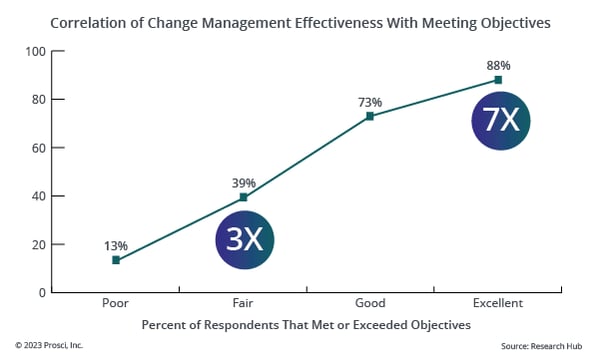How to Prevent the Missing Sponsor in Change Management

4 Mins
Updated: September 1, 2023
Published: August 21, 2015

Why are sponsors so important during organizational change? A sponsor's involvement sends a strong signal to the rest of the organization. If the sponsor actively and visibly supports the change, individuals in the organization notice. If the sponsor announces the change and disappears, individuals in the organization notice that too. The effectiveness of the sponsor is one of the strongest predictors of project success or project failure.
Having a missing or inadequate sponsor leads to consequences. Resistance to change increases among impacted employees. The team encounters more obstacles and is unable to resolve critical conflicts with scheduling, resources and scope. Changes are often delayed. And when a sponsor has not built the necessary coalition of support, changes fail to gain momentum across the organization. These consequences erode the value a change delivers, including return on investment (ROI). Given the importance of the initiatives in your organization, the challenge of a missing sponsor must be addressed.
Need a simple template to guide your engagement with your sponsor? Try our Sponsor Start-Up Checklist.
Signs of Inadequate Sponsorship During Change
How do you know when your change management sponsor has "gone missing" during a change?
- They don't understand the role of sponsor – not seeing their role beyond signing a check and charter. They have not embraced the "active and visible" role required for project success.
- They fail to personally engage – not giving the necessary energy, effort and focus to being active and visible.
- They are present only at the start of the change – launching a change, then moving on to other issues, which leaves the change to progress (or flounder) on its own.
- They abdicate sponsorship to someone else in the organization – delegating sponsorship responsibilities of sponsor to the project team, an outside consultant, or a different manager in the organization.
- They have too many initiatives underway – diluting their effectiveness. Sponsoring a change takes time and energy. If there are too many changes going on at one time, a sponsor will not have the necessary capacity to fulfill the role on each one.
Unfortunately, ineffective sponsorship is not a rare occurrence. In Prosci's Best Practices in Change Management benchmarking study, participants cite the lack of executive support and active sponsorship their top obstacle to success with change.
Tactics to Help an
Ineffective Sponsor of Change
Although some sponsors of change may go missing when you need them during change, you can take steps to prevent problems or mitigate the negative effects:
1. Demonstrate why change leadership matters
The first tactic is about building support for and commitment to the importance of sponsorship. You must make a compelling case to senior leaders about why change management is needed on the project, as well as the critical need for them to fulfill the role of a good sponsor. You must connect change management and their active and visible involvement to the business results and financial performance of the projects they sponsor. Your sponsors must say, "Change management is important, and my role as a sponsor is key to success" before they will begin fulfilling the role.
There are numerous approaches for helping sponsors see the impact of change management and sponsorship. From a qualitative perspective, you can illustrate the consequences of not managing the people side of change. This cost-avoidance tactic highlights delays in project deployment, resistance, productivity declines, impacts on customers, lower morale and other consequences of poor sponsorship.
To paint a clear picture of what the change looks like with and without effective sponsorship, you should share the growing body of data that links project performance to effective change management. Prosci's correlation data clearly shows that shows that projects with excellent change management are seven times more likely to meet objectives than those with poor change management.

You can also create scenarios to demonstrate how ineffectively managing the people side of change directly impacts the expected ROI for the project. Your goal is to show leaders the impact of sponsorship on the financial performance of their projects.
2. Develop your leader's competencies in change sponsorship
Many sponsors need help understanding what it really means to be a great sponsor because the concept is vague or change management is new to them. Most senior leaders, when presented with the specific activities they need to complete, will fulfill the role admirably. Your challenge as a change practitioner is to show them what a sponsor of change must do to be effective.
Prosci defines this as the ABCs of Sponsorship:
- Active and visible participation throughout the project lifecycle
- Build a coalition of sponsorship
- Communicate directly with employees
Although sponsors are one of Prosci's core roles in change management, many leaders find being a great sponsor of change to be a new leadership competency. The role of the leader in times of change has shifted as organizations have empowered their workforces. As a result, we need to treat change sponsorship as a leadership competency that can be taught and developed.

3. Coach your sponsor on their change management role
The final tactic for helping the missing sponsor is coaching. In times of change, the change practitioner must work with and through others, which includes preparing and equipping the sponsor. Most leaders are very busy and need support if they are going to be the active and visible sponsor you need. Your role is to do the leg work for them, such as identifying members of the sponsor coalition, scheduling one-on-one meetings, creating talking points, and putting meetings and appearances on their calendar.
The idea of coaching sponsors can be daunting. However, if you make a compelling case for change management and clearly demonstrate what the role of a great sponsor is, you'll be on the right track. Once they see the big picture, good leaders will ask what they can do to help the change succeed. This opens up your coaching relationship and is the beginning of great sponsorship.
Prepare and Support
Change Management Sponsors
Sponsors play a critical role during any project or initiative. Employees look to them for key information about the change and expect them to be active and visible. But sponsors often don't understand their importance or what they're expected to do during change, and may go missing when you need them most. To head off this problem, change practitioners must play an enabling role, equipping and supporting sponsors, so they can execute their responsibilities effectively during change.



